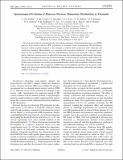| dc.contributor.author | Paz-Soldan, C. | |
| dc.contributor.author | Cooper, C. M. | |
| dc.contributor.author | Aleynikov, P. | |
| dc.contributor.author | Pace, D. C. | |
| dc.contributor.author | Eidietis, N. W. | |
| dc.contributor.author | Brennan, D. P. | |
| dc.contributor.author | Hollmann, E. M. | |
| dc.contributor.author | Liu, C. | |
| dc.contributor.author | Lvovskiy, A. | |
| dc.contributor.author | Moyer, R. A. | |
| dc.contributor.author | Shiraki, D. | |
| dc.contributor.author | Granetz, Robert S | |
| dc.date.accessioned | 2017-06-26T15:45:01Z | |
| dc.date.available | 2017-06-26T15:45:01Z | |
| dc.date.issued | 2017-06 | |
| dc.date.submitted | 2017-01 | |
| dc.identifier.issn | 0031-9007 | |
| dc.identifier.issn | 1079-7114 | |
| dc.identifier.uri | http://hdl.handle.net/1721.1/110251 | |
| dc.description.abstract | Novel spatial, temporal, and energetically resolved measurements of bremsstrahlung hard-x-ray (HXR) emission from runaway electron (RE) populations in tokamaks reveal nonmonotonic RE distribution functions whose properties depend on the interplay of electric field acceleration with collisional and synchrotron damping. Measurements are consistent with theoretical predictions of momentum-space attractors that accumulate runaway electrons. RE distribution functions are measured to shift to a higher energy when the synchrotron force is reduced by decreasing the toroidal magnetic field strength. Increasing the collisional damping by increasing the electron density (at a fixed magnetic and electric field) reduces the energy of the nonmonotonic feature and reduces the HXR growth rate at all energies. Higher-energy HXR growth rates extrapolate to zero at the expected threshold electric field for RE sustainment, while low-energy REs are anomalously lost. The compilation of HXR emission from different sight lines into the plasma yields energy and pitch-angle-resolved RE distributions and demonstrates increasing pitch-angle and radial gradients with energy. | en_US |
| dc.description.sponsorship | United States. Department of Energy (DE-FC02-04ER54698) | en_US |
| dc.description.sponsorship | United States. Department of Energy (DE-FG02-07ER54917) | en_US |
| dc.description.sponsorship | United States. Department of Energy (DE-AC05-00OR22725) | en_US |
| dc.description.sponsorship | United States. Department of Energy (DE-FC02-99ER54512) | en_US |
| dc.description.sponsorship | United States. Department of Energy (DE-SC0016268) | en_US |
| dc.publisher | American Physical Society | en_US |
| dc.relation.isversionof | http://dx.doi.org/10.1103/PhysRevLett.118.255002 | en_US |
| dc.rights | Article is made available in accordance with the publisher's policy and may be subject to US copyright law. Please refer to the publisher's site for terms of use. | en_US |
| dc.source | American Physical Society | en_US |
| dc.title | Spatiotemporal Evolution of Runaway Electron Momentum Distributions in Tokamaks | en_US |
| dc.type | Article | en_US |
| dc.identifier.citation | Paz-Soldan, C.; Cooper, C.M.; Aleynikov, P.; Pace, D.C.; Eidietis, N.W. et al. "Spatiotemporal Evolution of Runaway Electron Momentum Distributions in Tokamaks." Physical Review Letters 118, 255002 (June 2017): 1- 6 © 2017 American Physical Society | en_US |
| dc.contributor.department | Massachusetts Institute of Technology. Plasma Science and Fusion Center | en_US |
| dc.contributor.mitauthor | Granetz, Robert S | |
| dc.relation.journal | Physical Review Letters | en_US |
| dc.eprint.version | Final published version | en_US |
| dc.type.uri | http://purl.org/eprint/type/JournalArticle | en_US |
| eprint.status | http://purl.org/eprint/status/PeerReviewed | en_US |
| dc.date.updated | 2017-06-23T21:45:24Z | |
| dc.language.rfc3066 | en | |
| dc.rights.holder | American Physical Society | |
| dspace.orderedauthors | Paz-Soldan, C.; Cooper, C.M.; Aleynikov, P.; Pace, D.C.; Eidietis, N.W.; Brennan, D.P.; Granetz, R.S.; Hollmann, E.M.; Liu, C.; Lvovskiy, A.; Moyer, R.A.; Shiraki, D. | en_US |
| dspace.embargo.terms | N | en_US |
| mit.license | PUBLISHER_POLICY | en_US |
| mit.metadata.status | Complete | |
